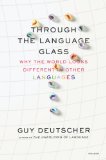Summary | Excerpt | Reviews | Beyond the Book | Read-Alikes | Genres & Themes | Author Bio

Critics' Opinion:
Readers' Opinion:
First Published:
Aug 2010, 320 pages
Paperback:
Aug 2011, 320 pages
 Book Reviewed by:
Book Reviewed by:
Jo Perry
Buy This Book
This article relates to Through the Language Glass
 Deutscher has much to say about the color "blue": its presence or absence in a language or culture, its sister-color, "green" with which it combines as a single hue in some languages, and notes that it is the color most difficult for children to learn.
Deutscher has much to say about the color "blue": its presence or absence in a language or culture, its sister-color, "green" with which it combines as a single hue in some languages, and notes that it is the color most difficult for children to learn.
Did you know?
Blue isn't the only slippery color. The German makers of this online color-naming quiz assert that culture (region) and gender affect what we see. I was surprised at how difficult it was to decide which color was what.
Disappearing Languages
Deutscher repeatedly demonstrates the crucial importance of the study of rare languages, and laments the rate at which these languages are being lost. National Geographic reports, "Every 14 days a language dies. By 2100, more than half of the more than 7,000 languages spoken on Earth - many of them not yet recorded - may disappear, taking with them a wealth of knowledge about history, culture, the natural environment, and the human brain." National Geographic's Enduring Voices Project identifies, documents and maps endangered languages in an effort to record the speakers' threatened culture.
Interesting Links:
Filed under Cultural Curiosities
![]() This "beyond the book article" relates to Through the Language Glass. It originally ran in October 2010 and has been updated for the
August 2011 paperback edition.
Go to magazine.
This "beyond the book article" relates to Through the Language Glass. It originally ran in October 2010 and has been updated for the
August 2011 paperback edition.
Go to magazine.





The Flower Sisters
by Michelle Collins Anderson
From the new Fannie Flagg of the Ozarks, a richly-woven story of family, forgiveness, and reinvention.

The House on Biscayne Bay
by Chanel Cleeton
As death stalks a gothic mansion in Miami, the lives of two women intertwine as the past and present collide.

The Funeral Cryer by Wenyan Lu
Debut novelist Wenyan Lu brings us this witty yet profound story about one woman's midlife reawakening in contemporary rural China.
Your guide toexceptional books
BookBrowse seeks out and recommends the best in contemporary fiction and nonfiction—books that not only engage and entertain but also deepen our understanding of ourselves and the world around us.